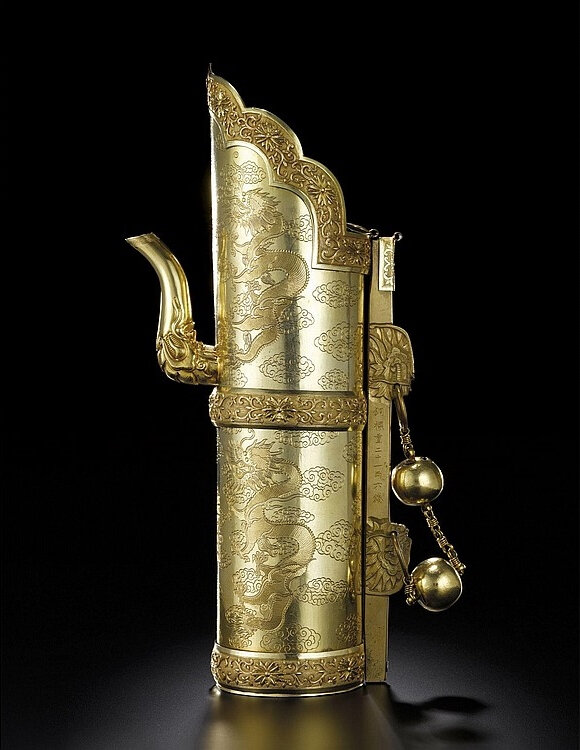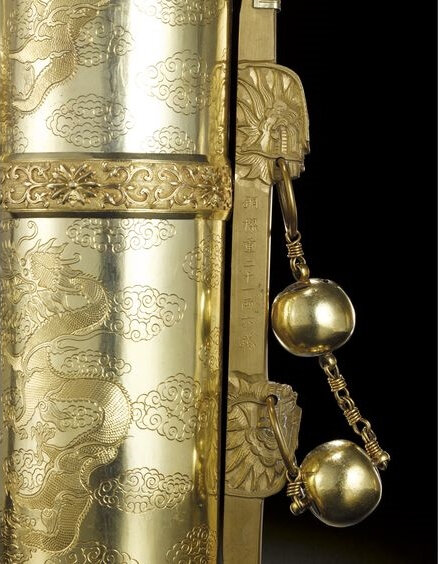A rare dated Tibetan-style gold 'marriage' ewer and cover, Guangxu mark and period, dated 1888
Lot 2615. A rare dated Tibetan-style gold 'marriage' ewer and cover, Guangxu mark and period, dated 1888; 48.5 cm., 19 in. Estimate 2,500,000 — 3,000,000 HKD. Lot Sold 6,620,000 HKD. Courtesy Sotheby's 2010.
the cylindrical body rising from a recessed base to a cusped crown and divided into two sections by a horizontal band cast with leafy floral strapwork, with similar bands at the base and rim, each section of the body incised with double xi characters ('happiness') and flanked by a long tailed phoenix and a five-clawed dragon amidst ruyi-head cloud scrolls, set one side with a curved upright spout rising from the open mouth of a dragon and to the other with a tall rectangular brass handle cast with a pair of confronted dragon heads, each pierced at the mouth and suspending a gold ring with two bells and a chain linking them, the handle with nine-character inscription Tong liang chong ershiyi liang liu qian ('brass handle weighting 21.6 ounces') the simple domed cover set with a ruyi boss and ring handle, the base with sixteen-character inscription Guangxu shisi nian, qi cheng jin chong yibai ershiwu liang jiu qian ('[Made in the] 14th year of the Guangxu reign, corresponding to 1888, of 70% pure gold weighting 125.9 ounces').
Note: Elaborately cast ritual vessels almost entirely made of gold convey opulence and luxury afforded by only the most powerful and wealthiest of people. The present ewer, fashioned from solid gold with the exception of the brass handle, is finely decorated with meticulously incised five-clawed dragons and ornate floral scrolls in low relief, and no other related example appears to have been published.
The use of precious materials combined with intricate decoration to transform what was originally a humble wooden ritual utensil into a splendid ceremonial vessel was first conceived by the Qianlong emperor as a deliberate expression of his devotion and political commitment to the patronage of Tibetan Buddhism. Duomuhu, or 'bucket for water' in Tibetan, were used in Tibet for storing butter and making the traditional buttered tea for Tibetan Buddhist ceremonies. When the emperor entertained Tibetan guests at formal occasions, the food was most likely in Manchu style with culturally sensitive tableware that included teapots for Manchu milk tea and pitchers in Tibetan style.
See a silver duomuhu of closely related form attributed to the Qianlong period, but with a plain body adorned with gilded floral-incised bands and brim, in the Tibet Museum, included in the exhibition Treasures from Snow Mountains. Gems of Tibetan Cultural Relics, Shanghai Museum, Shanghai, 2001, cat. no. 106, together with a gilded copper example of more squat form and openwork bands of decoration, cat. no. 105. For further earlier examples of duomuhu made in different mediums, see a Qianlong gold and cloisonné enamel ewer, with a reign mark and of the period, in the Palace Museum, Beijing, illustrated in The Complete Collection of Treasures of the Palace Museum. Metal-bodied Enamel Ware, Hong Kong, 2002, pl. 108; a gold, cloisonné and Beijing enamel example, also with Qianlong reign mark and of the period, included in the exhibition China. The Three Emperors, Royal Academy, London, 2006, cat. no. 54, sold in these rooms, 11th April 2008, lot 2842, exhibited together with a faux-bois copy, cat. no. 55.
Sotheby's. Fine Chinese Ceramics & Works of Art, 08 Oct 10 11:00 AM, Hong Kong

/https%3A%2F%2Fprofilepics.canalblog.com%2Fprofilepics%2F1%2F0%2F100183.jpg)
/https%3A%2F%2Fstorage.canalblog.com%2F03%2F02%2F119589%2F96711876_o.jpg)
/https%3A%2F%2Fstorage.canalblog.com%2F11%2F31%2F119589%2F94773502_o.jpg)
/https%3A%2F%2Fstorage.canalblog.com%2F20%2F83%2F119589%2F94772815_o.jpg)
/https%3A%2F%2Fstorage.canalblog.com%2F26%2F72%2F119589%2F75604929_o.jpg)
/https%3A%2F%2Fstorage.canalblog.com%2F59%2F60%2F119589%2F26458628_o.jpg)






/http%3A%2F%2Fstorage.canalblog.com%2F19%2F00%2F119589%2F112388922_o.jpg)
/http%3A%2F%2Fstorage.canalblog.com%2F97%2F30%2F119589%2F112306654_o.jpg)
/http%3A%2F%2Fstorage.canalblog.com%2F49%2F69%2F119589%2F112290735_o.jpg)
/http%3A%2F%2Fstorage.canalblog.com%2F96%2F16%2F119589%2F112073588_o.jpg)